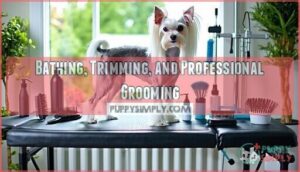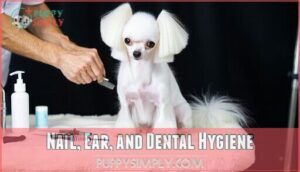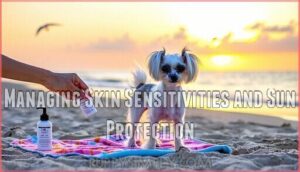This site is supported by our readers. We may earn a commission, at no cost to you, if you purchase through links.

Both varieties can appear in the same litter, sharing the same playful temperament and compact 8-12 pound frame, but their grooming demands couldn’t be more different. If you’re drawn to the Powderpuff’s silky elegance, you’ll need to understand what sets this coated version apart—from daily brushing requirements to health considerations that affect both varieties.
Table Of Contents
- Key Takeaways
- Chinese Crested Powderpuff Breed Overview
- Grooming and Daily Care Needs
- Health Issues and Genetic Concerns
- Training, Socialization, and Essential Supplies
- Frequently Asked Questions (FAQs)
- Are Chinese Crested powder puffs rare?
- How big does a Chinese Crested powder puff get?
- What is the difference between Chinese Crested and powder puff?
- How much does a Chinese Crested powder puff cost?
- Are Chinese Crested Powderpuffs hypoallergenic?
- Do they bark excessively?
- Are they good with other pets?
- How much do Powderpuff puppies cost?
- Are they prone to separation anxiety?
- What is the typical purchase price range?
- Conclusion
Key Takeaways
- The Chinese Crested Powderpuff isn’t hypoallergenic despite common misconceptions—both hairless and coated varieties produce allergens through dander, saliva, and skin oils, though the Powderpuff’s full coat may reduce airborne dander compared to shedding breeds.
- Daily brushing is non-negotiable for Powderpuffs to prevent matting in their double coat, requiring pin brushes, slicker brushes, and metal combs along with leave-in conditioners—far more maintenance than the hairless variety’s moisturizing and sun protection needs.
- Proactive health screening catches breed-specific issues early, including dental disease (affecting 80% of dogs by age two), progressive retinal atrophy, patellar luxation, and hip dysplasia—with genetic testing costing $128-$189 potentially extending lifespan past 15 years versus the 13.4-year average.
- These 8-12 pound toy dogs form intense bonds that make them highly prone to separation anxiety, requiring consistent early socialization between 8-16 weeks and positive reinforcement training to prevent destructive behaviors when left alone.
Chinese Crested Powderpuff Breed Overview
The Chinese Crested Powderpuff isn’t your typical toy breed—it’s got a look that turns heads and a personality that wins hearts. Before you bring one home, you’ll want to understand what makes this breed tick, from its soft, flowing coat to its compact size and affectionate nature.
Let’s break down the essentials you need to know about this charming little companion.
Unique Appearance and Coat Types
The Chinese Crested comes in two distinct coat varieties that look like they’re from completely different breeds—the hairless version sports silky tufts on the head, feet, and tail, while the Powderpuff is covered head to paw in a soft, flowing double coat.
Both hairless varieties and Powderpuff types meet breed standards, though their grooming needs couldn’t be more different:
- Hairless dogs need moisturizing and sun protection for exposed skin conditions
- Powderpuff grooming demands regular brushing to prevent matting in that double-layered coat texture
- Canine coat types vary dramatically even within the same litter
- Chinese Crested genetics determine which variety you’ll get
Size, Weight, and Temperament
Whether you’re eyeing the hairless or the fluffball version, both clock in at a petite 11–13 inches tall and a featherweight 8–12 pounds—perfect lap dog size with a personality that’s way bigger than the package suggests. These toy dog breeds pack alert, happy temperaments into compact frames, making them ideal companions for singles and families alike.
| Physical Trait | Standard Range |
|---|---|
| Height | 11–13 inches |
| Weight | 8–12 pounds |
| Body Proportions | Compact, balanced toy build |
| Temperament Traits | Alert, affectionate, playful |
Chinese Crested dogs show minimal size variations between varieties, though weight management matters more for their delicate frames. Growth patterns usually stabilize by one year, with dog personality and temperament developing through early socialization. Don’t let their dainty appearance fool you—these small dog breeds bond intensely and thrive on human connection.
Suitability for Allergy Sufferers
If you’ve been searching for a dog that won’t trigger your allergies, you might think the hairless variety is your golden ticket—but here’s the truth: no dog is 100% hypoallergenic, even one without hair. Allergic reactions stem from pet dander, saliva, and skin oils—not just fur.
Both hairless and Powderpuff Chinese Crested dogs produce allergens, though hairless dogs may reduce exposure since loose hair doesn’t scatter dander everywhere.
People with sensitive skin often tolerate this breed better than heavier-shedding types, but test your reaction before committing.
Origins and Historical Development
Despite their name, this breed’s ancient roots stretch far beyond China. Genetic legacy shows they share DNA with Mexican and Peruvian hairless dogs dating back thousands of years. Chinese sailors likely spread them via maritime trade routes starting in the 1500s, prizing their rat-catching skills aboard ships.
Historical records confirm global dissemination through European ports by the 1700s. The American Kennel Club recognized them in 1991, with modern breed clubs tracing nearly all Chinese Powder Puff lines to 20th-century breeding programs.
The Chinese Crested requires regular dental care checks to prevent common health issues.
Grooming and Daily Care Needs
Your Powderpuff’s luxurious double coat won’t maintain itself—it demands consistent attention to prevent matting and keep your dog comfortable. Beyond brushing, you’ll need to manage their skin, teeth, and nails to avoid common health issues down the line.
Here’s what your grooming routine should cover.
Brushing and Coat Maintenance Tips
A Powderpuff’s luxurious double coat can turn from silky to tangled mess faster than you’d think—daily brushing isn’t just recommended, it’s non-negotiable. Use the right grooming tools to prevent mat removal nightmares:
- Pin brushes work best for shedding control and detangling
- Slicker brushes tackle stubborn mats near the chest and legs
- Metal combs reach the undercoat for thorough coat conditioning
- Leave-in conditioners make dog grooming sessions smoother
Regular canine coat maintenance keeps your Powderpuff looking show-ready.
Bathing, Trimming, and Professional Grooming
Your Powderpuff needs a bath every two to three weeks to keep that coat clean without stripping natural oils—but here’s the catch: it’s what you do before and after the tub that really counts. Pre-bath brushing prevents matting nightmares, while conditioning treatments protect delicate skin care needs.
Between baths, trim around paws and sanitary areas using quality grooming tools—hairless dogs might steal the spotlight, but your Powderpuff’s canine coat requires serious shedding control through strategic hair trimming and consistent dog grooming routines.
Nail, Ear, and Dental Hygiene
Neglecting nails, ears, and teeth isn’t just lazy grooming—it’s a fast track to painful infections and costly vet visits that no Powderpuff owner should risk.
Here’s how to stay ahead of these common issues:
- Nail trimming every three weeks prevents painful splitting and awkward gaits that mess with joint alignment.
- Weekly ear cleaning with proper solutions stops bacteria buildup before infections take hold.
- Daily brushing combats gum disease—the silent killer affecting 80% of dogs by age two.
- Professional dental care catches early tooth loss before your dog’s oral hygiene becomes a serious health issue.
Managing Skin Sensitivities and Sun Protection
Think your Powderpuff’s fluffy coat shields them from the elements—but bare skin underneath tells a different story when sun exposure and temperature swings wreak havoc. Apply sunscreen products designed for dogs to exposed areas, establish a moisturizing routine with hypoallergenic lotions, and limit midday walks during peak heat protection hours.
Regular skin care checks catch sensitive skin conditions early—especially essential for hairless relatives prone to breed-specific health issues requiring targeted health testing.
Health Issues and Genetic Concerns
Your Powderpuff Chinese Crested isn’t just adorable—they’re also genetically wired for certain health challenges you need to know about. From dental troubles to joint issues, understanding what’s common in this breed helps you catch problems early and keep your pup thriving.
Let’s break down the main health concerns, prevention strategies, and care essentials that’ll help your Chinese Crested live their best life.
Common Dental, Eye, and Joint Problems
Chinese Crested dogs don’t get a free pass on health problems—dental disease, eye conditions, and joint issues top the list. Regular health screening and veterinary advice help catch these breed-specific health issues early.
Common concerns you’ll encounter:
- Dental care challenges – Early tooth loss and gum disease strike hard, often before age two
- Eye problems – Cataracts and progressive retinal atrophy can lead to blindness
- Patellar luxation – Kneecaps slip out of place, causing pain and mobility issues
- Hip dysplasia – Inherited joint malformation affects movement and comfort
- Legg-Calvé-Perthes disease – Hip joint deterioration requiring close monitoring
Understanding the dog breed specifics is essential for identifying potential health issues.
Stay proactive with canine health checkups to protect your dog’s wellness.
Preventing Parasites and Infections
Fleas, ticks, and worms aren’t just annoying—they’re health thieves that can wreak havoc on your Powderpuff’s skin, ears, and overall well-being. Parasite control and infection prevention start with consistent vaccination schedules and year-round flea management. Regular skin care checks catch problems early, protecting your dog’s health and wellness from breed-specific health issues.
| Parasite Type | Prevention Method | Frequency |
|---|---|---|
| Fleas | Topical treatments or oral medication | Monthly |
| Ticks | Tick collars and yard maintenance | Monthly check |
| Heartworms | Preventive medication | Monthly |
| Intestinal worms | Deworming treatments | Every 3-6 months |
| Ear mites | Regular ear cleaning and inspection | Weekly |
Importance of Health Screening and Testing
Proactive disease prevention begins long before symptoms appear. Genetic testing reveals hidden mutations linked to eye disease, joint disorders, and neurological conditions—giving you the power to act early. DNA panels costing $128 to $189 screen for over 10 hereditary markers, while health certifications from OFA and CHIC verify breeding stock quality. Screening protocols aren’t optional extras—they’re diagnostic tools that protect your Powderpuff from preventable suffering.
What regular health screening catches:
- Progressive retinal atrophy before your dog loses sight completely
- Primary lens luxation tied to a specific ADAMTS17 gene mutation
- Patellar luxation severity that can guide surgical decisions
- Early cardiac changes that medications can slow or reverse
- Dental disease patterns that predict tooth loss by age 8
Annual wellness exams with blood work and eye assessments can push your Crested’s lifespan past 15 years—well above the breed average of 13.4 years. Responsible breeders use CHIC databases to track results, ensuring you’re not gambling with canine genetics and testing outcomes.
Exercise, Weight Management, and Nutrition
Your Powderpuff’s genetic blueprint matters less than what you put in their bowl and how often they move—because even dogs with spotless pedigrees can develop obesity, joint strain, and metabolic disorders when calories outpace activity.
Daily exercise through 20-minute walks and indoor play keeps your 8–12 pound companion lean. Weight control hinges on balanced diets with high-quality protein—skip the table scraps and swap processed treats for healthy snacks like carrot sticks.
Nutrition plans customized to breed characteristics prevent the joint stress that plagues toy dogs.
Training, Socialization, and Essential Supplies
Your Powderpuff won’t raise itself into a well-mannered companion—you’ve got to put in the work from day one. Training and socialization shape how your dog navigates the world, while the right supplies and routine keep them thriving.
Here’s what you need to know to set your Chinese Crested up for success.
Early Socialization and Behavior Training
Starting socialization early—ideally between 8 and 16 weeks—gives your Chinese Crested Powderpuff the confidence and adaptability they’ll need to thrive in different situations throughout their life. Puppy socialization programs like the AKC S.T.A.R. Puppy provide structured social learning that strengthens canine communication skills and prevents behavior issues down the road.
Focus your training and behavior efforts on:
- Exposing your pup to varied environments—busy streets, quiet parks, friend’s homes—so they learn the world isn’t scary.
- Introducing diverse people and dogs to build breed characteristics like alertness without anxiety.
- Rewarding calm responses during new experiences to reinforce confident dog behavior through training techniques that stick.
Positive Reinforcement Techniques
Once your Powderpuff knows how to behave around new faces and places, the real magic happens when you teach them why good behavior pays off—literally. Clicker training and reward systems leverage operant conditioning to shape canine motivation naturally.
Mark the exact moment your dog nails a behavior, then reward instantly—that’s behavioral shaping in action. This dog training approach builds enthusiasm while strengthening your bond through consistent positive reinforcement.
Recommended Nutrition and Daily Activities
Feeding your Powderpuff the right fuel and keeping them active every day forms the foundation for a long, vibrant life—no shortcuts here. Balance high-quality small dog nutrition with moderate exercise and activity to prevent weight gain and keep joints healthy.
Here’s how to ensure your Powderpuff thrives:
- Nutrition Plans: Choose age-appropriate feeding guidelines that match your dog’s activity levels—portion control matters for toy breeds.
- Meal Scheduling: Feed twice daily on a consistent schedule to regulate metabolism and prevent overeating.
- Daily Exercise: Short walks plus indoor play satisfy their energy needs without overexertion—about 30 minutes total keeps them thriving.
Frequently Asked Questions (FAQs)
Are Chinese Crested powder puffs rare?
Chinese Crested dogs come in two coat varieties—hairless and powderpuff—and both are considered rare toy breeds.
The powderpuff’s full, silky coat results from a recessive gene, making them less common than their hairless counterparts in breeding programs.
How big does a Chinese Crested powder puff get?
These small dogs stand 11–13 inches tall and weigh just 8–12 pounds.
That compact size makes them easy to manage, whether you’re grooming or cuddling—perfect for apartment living or traveling with your pup.
What is the difference between Chinese Crested and powder puff?
Two distinct coat variations define this single breed—the hairless variety showcases smooth, soft skin with tufts on head, tail, and feet, while the powderpuff boasts a full, silky double coat covering their entire body.
How much does a Chinese Crested powder puff cost?
Purchase price for a puppy generally ranges from $1,000 to $2,000, though some breeders charge up to $5, Adoption fees through rescues run $600 to $1, Breeder costs vary based on lineage and breed characteristics.
Are Chinese Crested Powderpuffs hypoallergenic?
Like a gentle breeze for sensitive souls, Powderpuff Chinese Crested dogs aren’t truly hypoallergenic. They shed less pet dander than many breeds and produce minimal hairless benefits, but no dog breed guarantees complete allergy prevention for those with sensitive skin concerns.
Do they bark excessively?
These dogs aren’t usually excessive barkers, but they’ll alert you when something catches their attention.
Training and socialization help manage their vocalization patterns, making bark control straightforward with consistent positive reinforcement techniques.
Are they good with other pets?
Generally, yes—with proper socialization tips and careful animal introductions, Chinese Cresteds adapt well to multi-pet homes. Their friendly temperament fosters pet compatibility, though household dynamics improve when you prioritize early socialization and monitor initial interactions closely.
How much do Powderpuff puppies cost?
Reputable breeders usually charge between $1,000 and $2,700 for this dog breed, with puppy prices varying by lineage, breeder fees, and health testing.
Adoption costs run lower, though powderpuff Chinese Crested rescues remain rare.
Are they prone to separation anxiety?
Yes, they’re highly prone to separation anxiety due to their deep attachment to their people. These dogs form intense bonds and struggle when left alone, often showing separation stress through destructive behavior or excessive barking—classic attachment issues that require patience and dog calming techniques.
What is the typical purchase price range?
You’ll find breeders’ fees ranging from $500 to $5,000 for these powderpuffs, depending on bloodlines and dog breed characteristics.
Adoption prices run lower, while pet insurance and ownership expenses add ongoing costs beyond the initial purchase.
Conclusion
Here’s the irony: you fell for that wild coat and thought grooming would be simple. The Chinese Crested Powderpuff demands more brushwork than most toy breeds combined.
Daily detangling, careful bathing, and consistent dental care aren’t optional—they’re survival tactics. But here’s the payoff: nail those routines, and you’ll discover a companion who thrives on your attention, returns your devotion tenfold, and proves that high-maintenance doesn’t mean difficult. Just committed.












